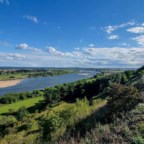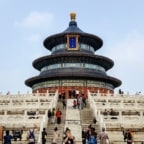We have another intense day ahead of us, so intense that we have to divide it into two posts ;) In this one we will offer you something for the soul, that is, we invite you to take a tour of two impressive temples, located in the center of Beijing.
There are places in Beijing that are easy to miss. As a rule, tours lead to the most important sites: Forbidden City, the Tian’anmen Plan, the Summer Palace, the Temple of Heaven, and of course a trip to the Great Wall. In addition, tours often include trips to Chinese markets and shopping districts.
However, if you decide to stay at least one day longer in Beijing, we highly recommend you to read our coverage of our next day in Beijing, this time divided into two posts. The places we are describing are not far from each other, in the so-called “walking distance,” and things to see include. Buddhist temple, Confucian temple, hutongs and towers with bell and drum. In this post we will focus on two temples.
Initially, we had planned only the Lama Temple and the hutongs for the day. The plan wasn’t very ambitious, but we had the comfort of spending a few days in Beijing itself, so we couldzłeverything out and go to the places we wanted to see without rushing. Of course, the plans didn’t have much to do with the final execution ;)
We took our first steps towards the Lama Temple.
Lama Temple
The temple is also known as the Temple of Harmony and Peace (Yonghegong). Even though we’ve slowly begun to get used to these fancy names, the former still stuck in our minds more. To reach it, you must get off at the“Yonghegong (Lama Temple)” station. This is the station for two lines: line number 2 (blue) and line number 5 (purple), and to enter the temple you have to go around it, so to speak, because the entrance is on the other side looking from the subway station.
The Lama Temple is a Tibetan monastery and is one of the most impressive Buddhist temples outside of Tibet (it is also the largest Buddhist temple in Beijing). Here we go through each pavilion in turn (there are a total of 5 main halls), with each successive one being even larger and more impressive than the previous one.
Panoramically it looks like this:
Please define valid width and height attributes for remote images. This will also optimize the loading time of the remote panorama.Eventually we arrive at a room with an 18-foot Buddha made of a single solid block of sandalwood! The statue is really huge and it is impossible to encompass it with your eyes (and camera) ;-)
Other pavilions are also noteworthy: bright colors, red buildings with yellow tiles, statues, statuettes, detailed ornaments, stunningly sumptuous rooms and oriental architecture. The pavilions contain numerous statues of deities.
And another panorama:
Please define valid width and height attributes for remote images. This will also optimize the loading time of the remote panorama.The atmosphere in the temple grounds is amazing: incense smoke, oriental smells, passing monks make it a magical place. The only thing that doesn’t fit is the crowds crowding the entrances to the pavilions, but it’s still good enough that we highly recommend you go to this place.
Confucius Temple
Straight from the Lama Temple, we headed toward the Confucius Temple, which is right next door, but covers a much larger area (22,000 sq. m.). It is the second largest Confucian temple in China (the largest is the temple in Qufu).
There is relative peace and quiet here. After visiting the Lama Temple and squeezing among the tourists, we hoped that things would be a little quieter here, and indeed they were. The very entrance proves it. In front of the entrance to the Lama Temple, the parking lot was clogged, coaches were standing, while here there were no cars at all, nor was there any queue for the ticket office.
The temple consists of four courtyards, and the most important structures are: First Teacher’s Gate (Xianshi Gate), Great Achievements Gate (Dacheng Gate), Great Achievements Pavilion (Dacheng Hall) and Prayer Pavilion (Chongshengci Hall). Most noteworthy is the “stone forest” with 198 stone tablets bearing the names of people from the Yuan, Ming and Qing dynasties who successfully passed the highest official examinations (a total of 51,624 names). There are also very old cypress trees on the grounds, and the oldest one is 700 years old!
Right next door, there is the Imperial Academy. The Academy educated future imperial officials and was the most important school in Beijing. It was here that readings of Confucian philosophy were held, performed by the emperor himself in front of students, professors and officials.
The atmosphere here is different from the Lama Temple, less atmospheric, but nevertheless it is also a place worth visiting, especially since it is on the way.
After seeing this Temple we went towards the hutongs and the famous “two towers”, but they already deserve a separate entry :)
Zobacz galerię zdjęć ze Świątyni Lamy oraz Świątyni Konfucjusza >>>




































